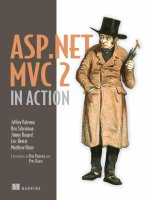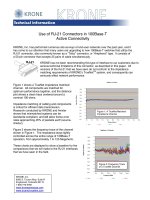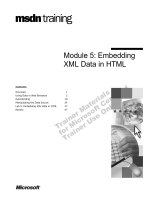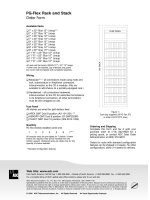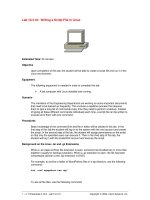Flex Mobile in Action pptx
Bạn đang xem bản rút gọn của tài liệu. Xem và tải ngay bản đầy đủ của tài liệu tại đây (11.07 MB, 381 trang )
MANNING
IN ACTION
www.it-ebooks.info
Advance Praise for Flex Mobile in Action
A must-read for anyone thinking of doing mobile apps. It’s simple enough for the novice
and deep enough for the pros.
—Ken Brueck
Director of User Experience, Protoven
Flex Mobile is cross-platform development at its best.
—Andrew Grothe
Developer, zedIT Solutions
An excellent introduction to the powerful ability of Flex and AIR to target
multiple mobile platforms.
—Kirsten Schwark
Senior Software Developer, iDashboards
Great cutting-edge techniques for mobile apps developers!
—Bill LaPrise
Owner/Developer, c3works
A very detailed and complete look at cross-platform mobile development
with Flex. Lots of great examples explaining the whats, hows, and whys
of mobile Flex development.
—Brian Genisio
Senior Software Consultant, SRT Solutions
Very handy code snippets, both for novice and day-to-day development.
—Fabien Nicollet
GIS Software Engineer, Business Geografic
It gets you building multi-platform real-world mobile apps in no time while
acquainting you with best coding practices and techniques.
—Alexandre Madurell
R&D Analyst Programmer, KIT digital
Get mobile applications running quickly with Flex on AIR. Very good for
learning, with extremely reusable examples.
—Doug Warren
Software Architect, Java Web Services
www.it-ebooks.info
Flex Mobile
in Action
JONATHAN CAMPOS
MANNING
SHELTER ISLAND, NY
www.it-ebooks.info
For online information and ordering of this and other Manning books, please visit
www.manning.com. The publisher offers discounts on this book when ordered in quantity.
For more information, please contact
Special Sales Department
Manning Publications Co.
20 Baldwin Road
PO Box 261
Shelter Island, NY 11964
Email:
©2012 by Manning Publications Co. All rights reserved.
No part of this publication may be reproduced, stored in a retrieval system, or transmitted, in
any form or by means electronic, mechanical, photocopying, or otherwise, without prior written
permission of the publisher.
Many of the designations used by manufacturers and sellers to distinguish their products are
claimed as trademarks. Where those designations appear in the book, and Manning
Publications was aware of a trademark claim, the designations have been printed in initial caps
or all caps.
Recognizing the importance of preserving what has been written, it is Manning’s policy to have
the books we publish printed on acid-free paper, and we exert our best efforts to that end.
Recognizing also our responsibility to conserve the resources of our planet, Manning books
are printed on paper that is at least 15 percent recycled and processed without the use of
elemental chlorine.
Manning Publications Co. Development editor: Cynthia Kane
20 Baldwin Road Technical proofreader: Kevin Korngut
PO Box 261 Copyeditor: Linda Recktenwald
Shelter Island, NY 11964 Proofreaders: Melody Dolab,
Nermina Miller
Cover designer: Marija Tudor
ISBN 9781617290619
Released as eBook only, May 2012
www.it-ebooks.info
iv
brief contents
PART 1 GETTING STARTED 1
1
■
Getting to know Flex Mobile3
PART 2 MOBILE DEVELOPMENT WITH FLEX 15
2
■
Get going with Flex Mobile 17
3
■
Persisting data 54
4
■
Using your device’s native capabilities 78
5
■
Handling multiresolution devices 128
PART 3 ADVANCED MOBILE DEVELOPMENT 155
6
■
MVC with mobile applications 157
7
■
Architecting multiscreen applications 218
8
■
Extending your mobile application 246
9
■
Effective unit testing 267
10
■
The almighty application descriptor 291
11
■
Building your application with Flash Builder 310
12
■
Automated builds using Ant 324
www.it-ebooks.info
v
contents
PART 1 GETTING STARTED 1
1
Getting to know Flex Mobile 3
1.1 Learning key terms 4
1.2 Deciding between native and cross-platform 4
1.3 What’s Flex Mobile? 6
What language am I coding in? 7
■
What runs our code? 7
1.4 Hello World 8
Prerequisites 8
■
Creating a new application 9
1.5 Introducing a running example 11
The roadmap for our example 12
■
Public APIs and Rotten
Tomatoes 12
■
The RottenTomatoesAS3 API 13
1.6 Summary 14
PART 2 MOBILE DEVELOPMENT WITH FLEX 15
2
Get going with Flex Mobile 17
2.1 Starting up your application 18
Creating a TabbedViewNavigatorApplication 19
The views 21
www.it-ebooks.info
vi
2.2 Running your application 23
Desktop run/debug configurations 23
■
Adding a device
configuration 27
■
Device run/debug configurations 29
2.3 Building your first application views 29
Navigating your application with the ViewNavigator 29
Providing context with the ActionBar 35
■
Updating the main
application 37
■
Creating the browse view 38
■
Creating the
list view 42
■
Creating the search view 48
■
Creating the
details view 50
2.4 Persisting navigator state 52
2.5 Summary 53
3
Persisting data 54
3.1 Storing data with the local shared object 55
Creating a local shared object 57
■
Interacting with a local shared
object 57
3.2 Storing data using SQLite 60
Connecting to SQLite 62
■
Creating a SQLite table 63
Reading from SQLite 65
■
Writing to SQLite 67
Deleting from SQLite 68
■
Updating a SQLite record 69
Adding public methods 70
■
Integrating with
SQLPersistenceManager 71
3.3 Simpler data storage with PersistenceManager 72
Interacting with PersistenceManager 73
■
Implementing
IPersistenceManager 74
3.4 Summary 77
4
Using your device’s native capabilities 78
4.1 Creating a device capability testing app 79
Creating a new application 79
■
Creating the menu view 80
Application descriptor file 82
4.2 Taking the same picture three different ways 84
Using the CameraUI the cross-platform way 86
■
Using the
getCamera() method 88
■
Accessing the device’s camera roll 91
Camera permissions 94
4.3 Monitoring movement with the accelerometer 94
Listening to the accelerometer 95
■
The values returned from the
accelerometer 96
www.it-ebooks.info
vii
4.4 Finding out where you are with geolocation 98
Adding the geolocation permissions 98
■
Getting location from the
geolocation sensor 99
4.5 Including the entire web with StageWebView 102
Connecting the StageWebView with the stage 103
■
Setting the
StageWebView location 104
■
Setting the StageWebView
content 105
4.6 Using gestures the right way, right away 105
Setting your touch input type 106
■
Using gestures 107
Using touch points 109
4.7 Texts, emails, maps, and phone calls 112
Sending SMS messages with SMS 113
■
Sending emails with
mailto 114
■
Navigating with Google Maps 115
■
Making a
phone call with tel 116
4.8 Recording sound with the microphone 117
Adding the microphone permission 117
■
Connecting to the
microphone 118
■
Recording and playing back audio 120
4.9 Responding to OS-specific inputs 122
Android operating system buttons 123
■
BlackBerry bevel
gestures 125
4.10 Summary 127
5
Handling multiresolution devices 128
5.1 Automatic scaling 131
Diving deep into automatic scaling 131
■
Enabling automatic
scaling 132
■
Considerations with automatic scaling 133
5.2 Using media queries in CSS 133
Starting up the CSS file 134
■
Adding color 136
■
Overriding
CSS based on DPI 138
■
Adding in hardware-specific CSS media
queries 141
5.3 Images for multiscreen projects 144
Organizing your images for multiscreen projects 144
Using the MultiDPIBitmapSource with an image 145
5.4 Overriding DPI returns to customize applicationDPI
values 146
Finding the capabilities values for each device 146
■
Overriding
the RuntimeDPIProvider 147
www.it-ebooks.info
viii
5.5 Splash screens 148
Basic splash screen 148
■
Multiresolution splash screen 152
5.6 Summary 154
PART 3 ADVANCED MOBILE DEVELOPMENT 155
6
MVC with mobile applications 157
6.1 What is Robotlegs? 161
How Robotlegs works 163
6.2 Hitting the ground running with Robotlegs 169
Creating the context shell 169
■
Connecting the context and
starting up the application 171
6.3 Separating your services 173
Creating your public methods 174
■
Transferring your result and
fault events 177
■
Mapping your service events to service
commands 181
6.4 Refactoring your data into models 186
Creating your model shell 188
■
Including the models in your
context 195
■
Creating your state model 196
6.5 Splitting your code into views and mediators 201
Creating the view 202
■
Wiring up your mediators 204
Adding handler methods 206
■
Connecting and disconnecting
your mediator 207
6.6 Application upgrade 210
Changing the main application 211
■
Building the
ApplicationMediator 214
6.7 Summary 217
7
Architecting multiscreen applications 218
7.1 Laying out a multiscreen application 219
Hub library 220
■
Spoke applications 220
7.2 Libraries 221
What’s a Flex library? 221
■
Setting up the library 223
Creating your base context 225
7.3 Android application 227
Setting up your Android application 228
■
Customizing the
view/mediators for Android capabilities 231
www.it-ebooks.info
ix
7.4 Creating your QNX-specific application 233
Setting up the QNX application 233
■
Customizing the view/
mediators for QNX capabilities 236
7.5 Creating your iOS-specific application 240
Setting up the iOS platform application 241
■
Customizing the
view/mediators for iOS capabilities 242
7.6 Summary 245
8
Extending your mobile application 246
8.1 Making money by adding ads 246
Not all platforms support ads 246
■
Not all ad systems are created
equal 247
■
Be honest or be punished 247
■
Integrating with
Google AdSense 248
■
Creating the HTML page 250
Integrating ads into your application 251
8.2 Native extensions 254
Including native extensions 255
■
Using a native
extension 259
8.3 Useful user tracking 259
Using Google Analytics for Flash 260
■
Plugging in
tracking 262
■
Integrating with tracking events in an
application 265
8.4 Summary 266
9
Effective unit testing 267
9.1 What is unit testing? 267
Test-driven development 268
■
Test-behind development 268
Flying blind 268
9.2 Testing terms 269
Test suite 269
■
Test case 270
■
Test method 270
Assert 271
■
What do you unit test? 271
9.3 Synchronous unit tests 272
Creating a RendererUtil class 272
■
Testing a utility class 273
9.4 Asynchronous test for event-driven tests 279
Testing a service call 279
■
Writing the tests 281
9.5 Running tests from the IDE 283
Using Flash Builder to run FlexUnit tests 283
Creating an application to run FlexUnit tests 287
9.6 Summary 290
www.it-ebooks.info
x
10
The almighty application descriptor 291
10.1 General application descriptor settings 291
AIR version 292
■
The all-important application ID 292
Application name and filename 293
■
Version number 293
Initial window settings 294
■
Application icons 295
Certificate file 296
10.2 Customizing your Android permissions 296
Available permissions 297
■
Filtering permissions 298
Permission features 299
10.3 QNX permissions for deployment 302
Available permissions 302
■
QNX splash screen and icon 303
Categories 304
10.4 Key points to iOS permissions 305
Filtering by device 305
■
Enabling features 306
10.5 Summary 309
11
Building your application with Flash Builder 310
11.1 Exporting a release build with Flash Builder 310
11.2 Android release process 311
11.3 QNX release process 314
11.4 iOS release process 319
11.5 Releasing to markets 322
11.6 Summary 323
12
Automated builds using Ant 324
12.1 Building with Ant 324
Ant terms 325
■
Running Ant 327
12.2 Your build setup 329
Prepping your property files 330
■
aying out your build
file 331
12.3 Using Ant to run FlexUnit 332
Updating your Test Runner application 334
■
The FlexUnit Ant
target 336
12.4 Showing off your code with ASDocs 338
Start by cleaning your old docs 338
■
Building your
ASDocs 338
www.it-ebooks.info
xi
12.5 Building your library 340
Completing the build target 340
■
build-library target 342
12.6 Packaging for Android 342
Compiling the Android project 344
■
Packaging the Android
project 345
12.7 Packaging for QNX (BlackBerry) 348
Compiling the QNX project 350
■
Packaging the QNX
project 352
■
Double-signing the BAR file 354
12.8 Packaging for iOS 355
Compiling the iOS project 357
■
Packaging the iOS
project 358
12.9 Final steps 361
FlexPMD, FlexCPD, and FlexMetrics 361
■
Master build
file 362
12.10 Summary 363
www.it-ebooks.info
xii
preface
It has been almost two years now since Adobe started releasing super-secret early betas
of their mobile AIR runtimes and Flex framework. During that time, only a select few
were kicking the tires and seeing what was possible while waiting for more phones to
successfully run Android 2.2 and the iPhone packager to be completed.
Fast forward a few months, and it’s October. Seconds after Adobe pushes up the
first versions of AIR for Android, I’m pushing up the first early version of my well-
received Queue Manager application—the first AIR for Android application on the
Android Market. Within a few months, planning on multiple projects for various proj-
ects is at full speed and many clients are adopting AIR and Flex for their mobile enter-
prise applications.
If we fast-forwarded a few more months, we’d see Queue Manager being used by
more than 20,000 unique users daily and having over 500,000 downloads. Between
personal and professional projects, I’ve created around a dozen mobile applications
that use Flex and AIR, and I was fortunate enough to be asked by Manning if I would
write a book about my experiences building Flex applications for the mobile environ-
ment. Originally, the request was to make a book showing how to use Flex to make
Android applications, but, as Flex developers, we know that we can do better and that
cross-platform development is the name of the game.
I’m proud to put into one book a collection of resources, examples, and explana-
tions that will help new Flex developers transition from desktop- and browser-based
applications to the mobile world, and assist any developers that want to make visually
stunning applications that execute consistently across multiple platforms with a singu-
lar and elegant code base.
www.it-ebooks.info
xiii
acknowledgments
Over the last few years, there have been many people that inspired me, leading me to
this point of actually releasing a book—something I said I would never do. First and
foremost, this book is created for the Flex community, a group of friends and col-
leagues that work together cohesively to help each other through the daily struggles
of development.
Beyond the community, I would like to thank Cynthia Kane for managing the
creation of this book, along with Troy Mott, Bert Bates, and the rest of the Manning
team. Within Manning, I would also like to give special thanks to Linda Recktenwald,
Melody Dolab, and Mary Piergies for making my techno babble readable.
Next, I’d like to give a special thank you to Kevin Korngut for going through all
my code and making sure that I didn’t leave any late-night programming errors in
the code.
I would like to thank the following reviewers who read the manuscript at various
stages during its development; their feedback made this a better book: Jason
Fincanon, Antonio Holguin, Brian Genisio, Ken Brueck, Andrew Grothe, Alexandre
Madurell, William LaPrise, Fabien Nicollet, Doug Warren, and Kirsten Schwark.
Finally, I want to say a special thank you to my family for their lifelong support and
to my wonderful girlfriend—my continuous source of inspiration.
www.it-ebooks.info
xiv
about this book
This book is about building Flex applications using the Adobe AIR runtime for multi-
ple mobile devices. More than just focusing on the coding conventions, this book
focuses on how to build a fully featured mobile application as well as all on the various
aspects of mobile application development.
Going beyond development and new Flex mobile features, this book integrates
often-requested and extremely useful application development features such as unit
testing, user tracking, MVC, Robotlegs, and ANT deployment. Utilizing every tool in
your tool belt will give you the ability to create fully featured enterprise applications
using Flex’s and AIR’s new mobile features.
Some developers may feel that these other features exist outside of the require-
ments for a Flex mobile development book. To these developers I would say that I’ve
included most of the typical needs for Flex mobile application developers—whether
the problem is Flex specific or not.
Roadmap
■
Chapter 1 starts with a general introduction to Flex mobile, mobile develop-
ment, and a simple Hello World example.
■
Chapter 2 hits the ground running by kicking off the Rotten Tomatoes Applica-
tion, setting up some views, and running the application on your desktop and
mobile device.
■
Chapter 3 builds upon chapter 2 by introducing data persistence to your appli-
cation using Local Shared Objects, SQLite, and the new PersistenceManager.
www.it-ebooks.info
xv
■
Chapter 4 diverges from the main application, creating a new application and,
specifically, showing how to use various device capabilities with Flex.
■
Chapter 5 returns to the Rotten Tomatoes application and updates your appli-
cation to work on a variety of devices, no matter the resolution or screen size of
the device.
■
Chapter 6 takes the Rotten Tomatoes application and gives it an industrial-
strength overhaul by introducing Robotlegs, an MVC micro-architecture.
■
Chapter 7 breaks up your Rotten Tomatoes application, enabling it to run
device-specific features while reusing the maximum amount of code.
■
Chapter 8 expands the Rotten Tomatoes application by introducing Native
Extensions, user tracking, and revenue-generating ads integration.
■
Chapter 9 goes beyond the Rotten Tomatoes application and builds in unit test-
ing.
■
Chapter 10 diverges from the Rotten Tomatoes application by focusing on the
Application Descriptor and all of the features enabled with this single file.
■
Chapter 11 shows how to use Flash Builder to create release-quality builds of
the application.
■
Chapter 12 rounds out the book by showing how to use ANT to automate the
build process of all the application’s parts.
Who should read this book?
This book is about building mobile applications using the Flex framework. As such,
this book targets two types of developers.
The first are current Flex developers interested in taking their knowledge to the
next level and onto the mobile landscape. Whether you’ve used Flex to develop small
widgets or built entire applications, there’s much to learn about the new mobile para-
digms and best practices when building multi-screen applications. For current Flex
developers, I’ll discuss the new components optimized for mobile development, archi-
tecture strategies for multi-screen applications, and how to create applications that
look and run great across multiple devices and multiple screen sizes.
The second type of developers that this book is intended for comes from other
languages and wants to create mobile applications. Rather than deciding to learn
Objective-C, Android Development, C++, C# or any of the other languages that create
installable mobile application, we can just use Adobe AIR coupled with Flex and build
applications that work on iOS, Android, BlackBerry, the web, and even the desktop
with a singular codebase. These developers are busy, hard-working, and ready to max-
imize their output. If you’re coming to Flex for the first time, you’ll quickly see how to
create MVC-based applications with Flex, use Flex to build mobile applications, and
release your mobile applications to each of the major markets.
www.it-ebooks.info
xvi
Code conventions and downloads
As this is a programming book, you can expect it to include many code samples, con-
figuration files, and other required listings to help you understand how to create Flex-
based mobile applications. Source code in listings or in body text is in a
fixed
width
font
to separate it from ordinary text. In addition to code listings, ActionScript class
and method names, parameters, properties, along with HTML and XML elements will
also be presented using
fixed
width
font
. ActionScript method names within text will
not include the full method signature—the name and list of required parameters.
Well-formatted code utilizes plenty of whitespace, improving readability, but a
book has limited space on a page, so I’ve had to condense the code listed in this
eBook. The full, nicely formatted, code can be found online in my GitHub account at
/> or on the publisher's website
at www.manning.com/FlexMobileinAction.
Under each code listing I include the path to find the specific file being discussed
in the listing. This is meant to make finding full code segments as simple as possible.
In some rare cases not all of the code is shown in the book—mainly due to repetitive
code. Complete applications, including these missing segments, can be found in my
GitHub account. You can also download the source code in a zip file from the pub-
lisher's website at www.manning.com/FlexMobileinAction
.
Also in the code listings, you will find code annotations that point out certain code
segments and explain what each individual line of code accomplishes.
Flex is an open source project, released under the Apache Software License and
distributed with the Adobe Flash Builder IDE and many others. You can also down-
load Flex, in source or binary form, from the Flex home page at http://incubator
.apache.org/flex/.
Author Online
The purchase of Flex Mobile in Action includes free access to a private web forum run by
Manning Publications, where you can make comments about the book, ask technical
questions, and receive help from the author and from other users. To access the
forum and subscribe to it, go to This page
provides information on how to get on the forum once you are registered, what kind
of help is available, and the rules of conduct on the forum.
About the author
Jonathan Campos is a principal architect for Miller and Associates as well as a commit-
ter on the Apache Flex project. Within the community Jonathan is a user group man-
ager in Dallas, Texas. You can see Jonathan’s blog at />jonbcampos and on twitter at
www.it-ebooks.info
xvii
about the cover illustration
The figure on the cover of Flex Mobile in Action is captioned “Flag Bearer of the Guard
in Dubrovnik, Croatia.” The illustration is taken from a reproduction of an album of
traditional Croatian costumes from the mid-nineteenth century by Nikola Arsenovic,
published by the Ethnographic Museum in Split, Croatia, in 2003. The illustrations
were obtained from a helpful librarian at the Ethnographic Museum in Split, itself sit-
uated in the Roman core of the medieval center of the town: the ruins of Emperor
Diocletian’s retirement palace from around AD 304. The book includes finely colored
illustrations of figures from different regions of Croatia, accompanied by descriptions
of the costumes and of everyday life.
Dubrovnik is an ancient city and sea port located on the Adriatic coast of Croatia.
A prime tourist destination today, the city was originally called Ragusa and founded in
the 7th century AD as a refuge for coastal residents fleeing advancing barbarians. In
the Middle Ages, Ragusa flourished and was the only city on the eastern Adriatic to
rival Venice in maritime power and trade. The figure on the cover is holding the flag
of Ragusa with a picture of St. Blaise on it. An early Christian martyr, St. Blaise is the
patron saint of Dubrovnik to this day.
Dress codes and lifestyles have changed over the last 200 years, and the diversity by
region, so rich at the time, has faded away. It’s now hard to tell apart the inhabitants of
different continents, let alone of different hamlets or towns separated by only a few
miles. Perhaps we have traded cultural diversity for a more varied personal life—cer-
tainly for a more varied and fast-paced technological life.
Manning celebrates the inventiveness and initiative of the computer business with
book covers based on the rich diversity of regional life of two centuries ago, brought
back to life by illustrations from old books and collections like this one.
www.it-ebooks.info
Part 1
Getting started
Application development is in a transition period no matter what applications you’re used to
creating. Applications are becoming apps, and the steps required to prepare applications for
the desktop and the web are continuing to grow to include many mobile platforms.
In this part of the book we’ll focus on some concepts and pain points when creating
mobile applications, including the issue of multiple operating systems and technologies. We’ll
also look at a quick Hello World example so that you can see how easy it is to create an
application for various platforms using Flex.
www.it-ebooks.info
www.it-ebooks.info
3
1
Getting to know Flex Mobile
This chapter covers
Defining multidevice and multiscreen
The great debate: native versus cross-platform development
Mobile components
Hello World example
You, a mild-mannered programmer, work tirelessly on your computer to create desktop and
web applications for your own personal gain and that of your clients. Suddenly you get a call
on your phone from a new client asking for a mobile application! You spring into action and
take the case only to realize later that mobile development is very different from the
application development you’ve done in the past. Enter Flex Mobile.
With the latest release of Flex, Flex 4.6—the successor to Flex 4.5 (codenamed Flex
Hero), you can easily make applications that run on the web, desktop, or a wide range of
mobile phones and tablets with the same codebase and familiar development techniques
between each platform. This means you don’t have to learn a new language or relearn how a
button works each time you need to deploy to a new device. Instead, you can use the
knowledge you have, extend it, and deploy to each new platform.
What makes Flex so wonderful for application development? Built into the Flex framework
is a myriad of components created with the sole purpose of creating amazing applications.
With many tested, extendable components, you can create applications easily without having
to re-create the wheel each time.
In this chapter we’ll discuss the latest changes in mobile application development, as well
as how to decide between going native and using a cross-platform solution. Once you see the
benefits of the Flash platform for multiscreen development, we’ll look at what Flex Mobile is,
work through a basic Hello World example, and finally introduce the running example that
will be used throughout the entirety of the book.
www.it-ebooks.info
4 CHAPTER 1 Getting to know Flex Mobile
1.1 Learning key terms
Before jumping right into Flex Mobile it’s important to understand some key terms
surrounding mobile and discuss the debate between native and cross-platform development.
N
ATIVE DEVELOPMENT
When we talk about going native, we’re referring to the use of the device’s native software
development kit (SDK), and therefore programming language, to create applications. For iOS
development you’ve probably heard that native development means learning the Objective-C
language, whereas Android includes its own framework built around the Java language.
C
ROSS-PLATFORM DEVELOPMENT
When we talk about going cross-platform, we’re talking about using one of the development
platforms, such as Flex (ActionScript) or HTML (and JavaScript), to create applications that
work similarly, if not the same, across all devices.
M
ULTIDEVICE AND MULTISCREEN
Thanks in part to the changing mobile landscape, two new terms are thrown around
surprisingly often: multidevice development and multiscreen development. Although some
circles may argue the unique differences of these terms, on the whole these terms are
synonymous.
When we talk about multidevice or multiscreen application development, we’re ultimately
discussing creating a single application that works on multiple devices or multiple screens.
Depending on your interpretation of the word, you may believe that the code is 100% the
same between each device or that the applications need to share a common codebase.
For some developers, when we talk about multidevice, we’re discussing the various
mobile platforms, and when we talk about multiscreen, we’re also bringing in web, desktop,
and television screens, to name a few. For the purposes of this book, we’ll treat the terms as
the same and focus specifically on creating an application that works across multiple
platforms.
1.2 Deciding between native and cross-platform
Within various development circles there’s a big debate: go native or go cross-platform.
Although the final answer is always unique to the team and developers, there are some
major points to take into consideration before making a final decision. I do want to point out
that either way you can create some great applications.
For native development, some reasons to use native code are the execution speed, ease
of access to core or custom features, and final package size. But the downside to going with
native code is the limited reuse of code, longer development cycles for projects requiring
multiple platforms, and more languages that your teams must be proficient in to successfully
execute an application.
www.it-ebooks.info
Getting to know Flex Mobile 5
With cross-platform development, some reasons to use a cross-platform language are the
development speed, consistency of applications across devices, time and cost savings, and
finally only having to master or use a single language. As with any decision, there are some
downsides. For cross-platform development, this usually means that it’s harder to access
core platform features, the final package size is usually larger to support multiple platforms,
and the code’s execution time is typically slower because there’s a level of abstraction
between the device and the code (see figure 1.1).
Figure 1.1 Cross-platform versus native development
It’s the points of time and cost savings that I want to focus on. As a consultant, all of my
clients want to create an amazing application while minimizing cost and maximizing their
return on investment. Therefore, many of my clients start the application development
process by focusing on a singular device platform that they want to target, usually Android
or iOS. If you’re creating an application for a singular device, you have the option to either
use native development techniques or cross-platform development techniques.
At some point, though, my clients always eventually ask the question, “Can my
application developed for platform X also work on platform Y?” Immediately, I tell them that
the only answer is to use cross-platform development without needlessly ballooning the
development cost and the amount of time necessary to fully support multiple platforms.
Because you’re reading this book, I assume you’re interested in cross-platform
development, specifically Flex Mobile.
www.it-ebooks.info
6 CHAPTER 1 Getting to know Flex Mobile
1.3 What’s Flex Mobile?
With the decision to use a cross-platform framework for your mobile applications behind you,
we’ll look at Flex Mobile specifically.
Some time back, before Flex 4.5+, Flex was already the best user interface framework on
the market for browser and desktop applications. Mobile devices were starting to take off,
and Adobe was planning to create a second lightweight framework influenced by Flex for
mobile devices, codenamed Slider. During the development and exploration of this
lightweight framework, the Flex SDK team found the best possible solution, combining the
lessons learned from the lightweight framework and optimizing the full Flex framework.
The Flash platform teams released Flex 4.5, providing the Flex framework we know and
love with the mobile optimizations of a mobile specific framework, along with some
industrial-strength upgrades to Flash Builder. Including components specifically for mobile,
Flex 4.5 took existing mobile components appropriate for the mobile user experience and
provided mobile skins that were size appropriate for touch input and multi-DPI layouts. The
codename for this merged mobile-capable framework was Hero.
Powered by thousands of active developers and contributors, the Flex framework is
always improving and expanding. At the time of this writing, Flex version 4.6 is just being
released, adding additional mobile components to the Flex framework. Figure 1.2 shows just
some of the Flex components skinned for mobile use. In addition to the selected list of
mobile components shown, many other components are available but are harder to visualize.
Figure 1.2 Small sample of Flex visual components skinned for mobile interaction
This simple description of Flex Mobile opens the door to many more questions. What
language am I coding in? What runs our code? Next, I’ll answer these questions.
www.it-ebooks.info
Getting to know Flex Mobile 7
1.3.1 What language am I coding in?
When developing a Flex application you’ll hear people use phrases like the MXML code, the
ActionScript code, or even the Flex code. Even poor, helpless recruiters will send out job
requests insisting the developers have three years of MXML development.
So what’s right?
Flex is a framework built using the ActionScript language. Whether you’re writing out
MXML markup or ActionScript code, you’re always writing in ActionScript. You’ll notice that I
used the words MXML markup rather than MXML code. This is because MXML is an XML-
based markup protocol created by Adobe for the Flex framework to make the layout of visual
components easier to read. As its popularity grew, other ActionScript frameworks used the
concept of MXML markup to use a tag-based markup to describe their ActionScript objects.
It doesn’t look like ActionScript to me.
MXML is purely an XML representation of the ActionScript objects. All of the rules of XML
still apply, such as namespaces and markup formatting. When compiling your application the
compilers within the Flex framework take your MXML tags and convert them to ActionScript
classes. After this translation is complete, the compiler creates the file to be run on your
runtime.
Can I see the generated code?
It’s a little too advanced to go into right now, but if you want to be able to see the
generated code created, you can always add –keep-generated-
actionscript=true to your compiler settings. See the following URL for the
application compiler options:
Now that you have a better understanding of the language, we need to discuss what
executes your code.
1.3.2 What runs our code?
A term you’ve probably heard before is runtime environment, also sometimes referred to as
just runtime. A runtime environment is a collection of code, settings, and programs that
execute the code you write. When developing with Flex there are two runtimes to be aware
of: the Flash Player runtime and the Adobe Integrated Runtime (AIR).
F
LASH PLAYER RUNTIME
The Flash Player runtime is the program that runs to execute a compiled application within
an internet browser. Flash Player is available for every major internet browser and provides a
consistent runtime and code executing experience. As wonderful as Flash Player can be, for
this book we won’t be concerned with Flash Player. The applications you’ll create all run on
the AIR runtime.
www.it-ebooks.info


